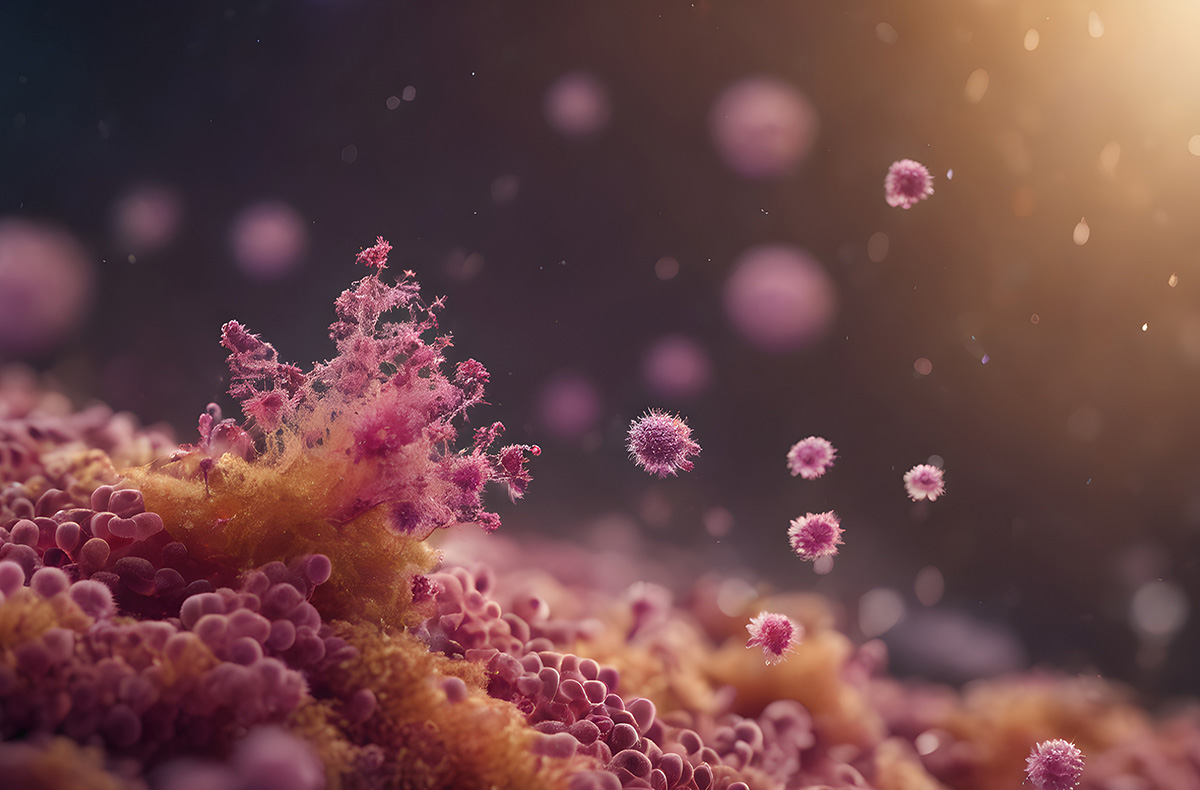A very powerful and specialised immune system exists in the gut. It is thought that around 80% of our body's immune cells reside here. This may seem exaggerated, but we need to understand why. The digestive tract is one of the barriers that separate our body from the outside world, along with the lungs, skin and other mucous membranes such as the oral and vaginal mucosa. Of all these barriers, it is the one with the largest surface area. Classically, it has been said to be about 250 to 300 metres in length.2 exchange surface, i.e. the size of a tennis court. However, recent publications speak of a smaller, but still very important, surface area of about 32 m2The equivalent of half a badminton court. We can therefore consider it to be the main "customs house" of our body. Every day, millions of substances (food molecules, micro-organisms, toxins, etc.) reach the intestine, and this organ has to decide for each of them whether to let them pass into the body or not. To do this, in addition to the function of the enterocytes (the cells that line the intestinal wall), it is assisted by the immune system, which acts as a customs police officer and asks for a "passport" for each of these substances.
Bibliography:
Arponen S (2021). Es la microbiota, idiota. Alienta.
Maynard CL, Elson CO, Hatton RD, Weaver CT. Reciprocal interactions of the intestinal microbiota and immune system. Nature. 2012 Sep 13;489(7415):231-41.
Cryan JF, O’Riordan KJ, Cowan CSM, Sandhu KV, Bastiaanssen TFS, et al. The Microbiota-Gut-Brain Axis. Physiol Rev. 2019 Oct 1;99(4):1877-2013.
Takiishi T, Fenero CIM, Câmara NOS. Intestinal barrier and gut microbiota: Shaping our immune responses throughout life. Tissue Barriers. 2017 Oct 2;5(4)
Martin-Gallausiaux C, Marinelli L, Blottiere HH, Larraufie P, Lapaque N. Short Chain Fatty Acids – mechanisms and functional importance in the gut. Proceedings of the Nutrition Society, 2021, 80 (1), pp. 37-49.
Helander HF, Fändriks L. Surface area of the digestive tract – revisited. Scand J Gastroenterol. 2014 Jun;49(6):681-9.
Maynard CL, Elson CO, Hatton RD, Weaver CT. Reciprocal interactions of the intestinal microbiota and immune system. Nature. 2012 Sep 13;489(7415):231-41.
Cryan JF, O’Riordan KJ, Cowan CSM, Sandhu KV, Bastiaanssen TFS, et al. The Microbiota-Gut-Brain Axis. Physiol Rev. 2019 Oct 1;99(4):1877-2013.
Takiishi T, Fenero CIM, Câmara NOS. Intestinal barrier and gut microbiota: Shaping our immune responses throughout life. Tissue Barriers. 2017 Oct 2;5(4).
Mitchell NM, Johnson JR, Johnston B, Curtiss R 3rd, Mellata M. Zoonotic potential of Escherichia coli isolates from retail chicken meat products and eggs. Appl Environ Microbiol. 2015 Feb;81(3):1177-87.
Buberg ML, Mo SS, Sekse C, Sunde M, Wasteson Y, Witsø IL. Population structure and uropathogenic potential of extended-spectrum cephalosporin-resistant Escherichia coli from retail chicken meat. BMC Microbiol. 2021 Mar 29;21(1):94.
Magruder M, Sholi AN, Gong C, et al. Gut uropathogen abundance is a risk factor for development of bacteriuria and urinary tract infection. Nat Commun. 2019;10(1):5521.
Magruder M, Edusei E, Zhang L, et al. Gut commensal microbiota and decreased risk for Enterobacteriaceae bacteriuria and urinary tract infection. Gut Microbes. 2020;12(1):1805281.
Spaulding CN, Klein RD, Ruer S, et al. Selective depletion of uropathogenic E. coli from the gut by a FimH antagonist. Nature. 2017;546(7659):528-532.
Jones-Freeman B, Chonwerawong M, Marcelino VR, Deshpande AV, Forster SC, Starkey MR. The microbiome and host mucosal interactions in urinary tract diseases. Mucosal Immunol. 2021 Jul;14(4):779-792.
Mitchell NM, Johnson JR, Johnston B, Curtiss R 3rd, Mellata M. Zoonotic potential of Escherichia coli isolates from retail chicken meat products and eggs. Appl Environ Microbiol. 2015 Feb;81(3):1177-87.
Buberg ML, Mo SS, Sekse C, Sunde M, Wasteson Y, Witsø IL. Population structure and uropathogenic potential of extended-spectrum cephalosporin-resistant Escherichia coli from retail chicken meat. BMC Microbiol. 2021 Mar 29;21(1):94.

